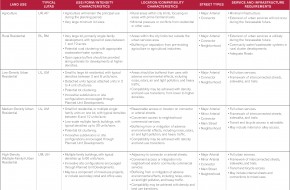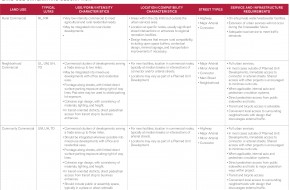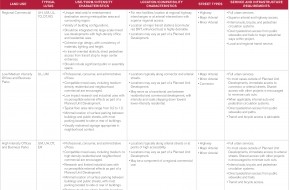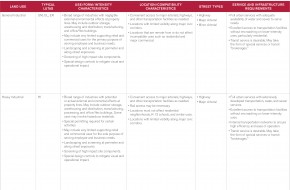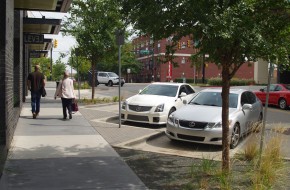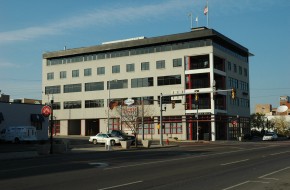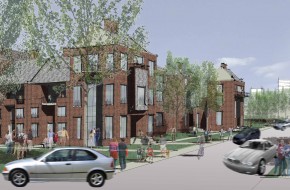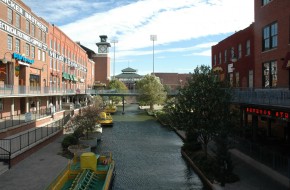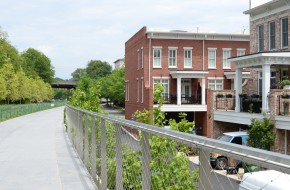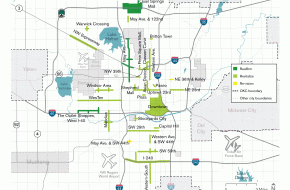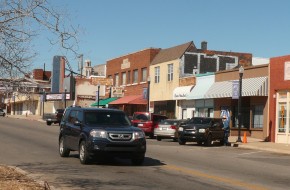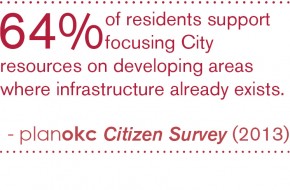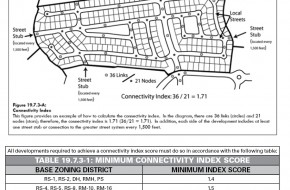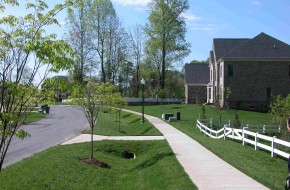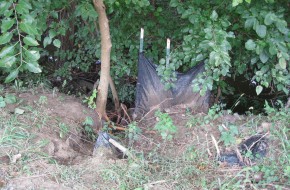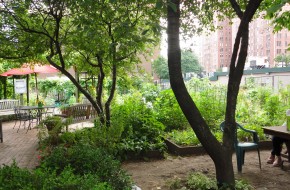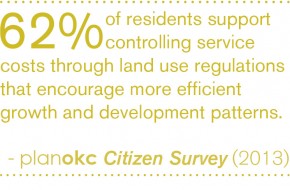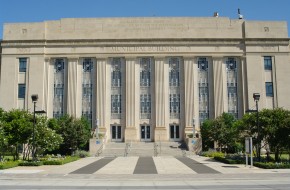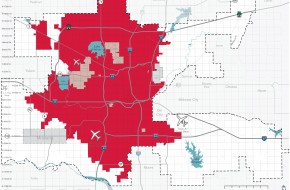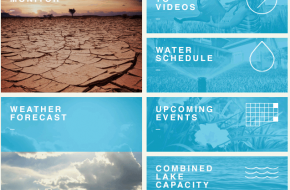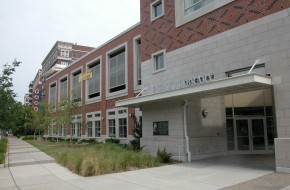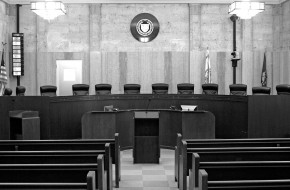The initiatives below relate to city services such as police, utilities, and fire protection. Click on any initiative to view a full explanation and related policies.
We will ensure that land uses are located on sites that meet their needs, work cohesively in their environments, and are served by appropriate transportation and infrastructure. While the LUTA concept encourages integration of uses, it does not suggest that any land use is appropriate anywhere. Commercial and industrial uses have particular needs for transportation, surrounding conditions, utilities, and visibility. Urban uses in general require water, wastewater, urban streets, and other infrastructure that can meet their demands for service. These individual requirements apply even in mixed-use environments. This makes specific criteria for location and design of individual uses especially important. Developers and builders will use these criteria as they select sites and design projects. Neighborhood residents will be reassured that potentially incompatible uses will be directed to appropriate sites. Approving groups will use criteria to evaluate the quality of development proposals and their compliance with the comprehensive plan. The tables shown on the right present a base for location and development criteria that should be refined and incorporated into new land use ordinances.
We will revise regulations to better protect residential uses from the negative effects of nearby non-residential uses. Traditional development ordinances attempt to shield residential uses from undesirable effects of adjacent uses by separation. Similar development types do tend to cluster together and keeping different uses apart sometimes works. However, use separation by itself produces inefficient and uninteresting development and often is not viewed as providing reliable protection. For example, Oklahoma City frequently uses Planned Unit Developments to control the details of conventional projects. However, the intention of PUDs was to provide flexibility for innovative development rather than inflexible controls on individual sites. Oklahoma City's new directions in land use planning and regulation instead will create standards and guidelines by which different uses reinforce rather than harm each other.
Certain uses are incompatible and cannot easily be neighbors. The land use system should retain some primary use categories for these situations. But in most cases, transitional standards that encourage mixed-use development and directly control potential incompatibilities should create a more efficient and vital city.
Click to expand policy information.
Coordinate the design, development, expansion, and/or investment in transportation projects with the Land Use Typology map.
Require traffic impact analyses with all comprehensive plan amendments requests to change to a higher intensity LUTA.
Revise Subdivision Regulations and development standards to reflect the street typology standards.
Seek opportunities to co-locate new public projects, such as libraries, fire stations, parks, and recreation centers near compatible civic uses such as schools and campuses to create nodes of activity and services.
Ensure that new publicly financed developments – those which directly use or receive public dollars – with more than 100 units or with densities greater than 10 units/acre are located where they have easy access to frequent transit service.
Modify codes to allow residential clustering in rural land use typology areas, provided water supply and sewage disposal requirements are met, and permanently preserve nearby open space through means such as conservation easements.
Coordinate planning efforts with school districts to attempt concurrent land purchases for schools and parks.
Ensure all homes are within walking distance of a park based on level of service standards for each urban land use typology by updating codes and regulations for new construction and by improving connections and access between existing parks and neighborhoods.
Establish procedures for creating new joint school/park sites, including the division of maintenance responsibilities.
Prioritize capital improvement to construct linkages and connections from the existing urban parks and open space system to neighborhoods, commercial areas, employment centers, and community facilities.
Form a working partnership with the library system, both the Metropolitan Library System and the Oklahoma Department of Libraries, to coordinate timing of facility expansions, improvements, and new facility siting with other types of civic resources, such as schools, fire stations, parks, and projected growth and demand for those resources. This should also include identifying a mechanism to provide library services in Canadian County.
Provide adequate infrastructure for new or expanding companies by giving priority to Capital Improvements in ER areas. Additionally, consider the implementation of impact fees for infrastructure in order to provide infrastructure in a timely manner and to better coordinate with private development.
Encourage the use of special service districts with enhanced levels of service.
Mitigate negative impacts of compactness by:
- Updating nuisance code to better address noise, smell, vibration, property maintenance, panhandling, animal control, delivery hours limits, and other possible negative effects.
- Updating the sign ordinance to reduce visual clutter.
Prioritize and concentrate development where facilities, infrastructure, and services have capacity and in areas where the Police and Fire Departments are best able to respond. Guide the location and timing of development through the proactive and strategic installation of infrastructure.
Encourage the integration of different land uses in urban areas through the following means:
- Promote the use of performance standards in place of existing zoning methods (which address incompatibility by separating uses). Performance-based regulations should focus on achieving compatibility between uses by addressing the following:
- Noise, odors and air quality
- Traffic and parking (allow flexible, but sufficient parking)
- Site layout and building design
- Waste
- Safety
- Lighting (glare control, placement, and shielding)
- Delivery hours
- Enhance transit service (bus and rail).
- Prevent large areas of concentration of any particular land use such as multi-family or commercial.
Higher density multifamily development should be located in areas near employment or educational centers where street and transit systems have, or will soon have capacity to support the added trips.
Avoid concentrations of apartment complexes. Instead, integrate multifamily units into neighborhoods with mixes of housing types or in mixed-use developments.
We will provide incentives and investments that produce a favorable environment for private investment on underutilized sites. In Oklahoma City, we have tended to view land as an inexhaustible and disposable resource, reducing the desirability of older areas and decreasing land values, while expanding the city's boundaries outward. The surveys and process of planokc show that this view is also changing, as citizens place a high value on using existing infrastructure and urban land effectively and rebuilding established neighborhoods. Preferences are also changing, as many families appreciate active urban places like Midtown and Automobile Alley that provide living, shopping, entertainment, and work places with good walking, bike, and transit access. Effective use of existing land resources is a central principle of Chapter Two's land use vision.
Redevelopment and infill depend on major private investment. City policy and action can create the conditions that help this private investment occur.
Directions for these policies include:
- Site assembly. Multiple property owners, often absent or very difficult to find, can make it impossible to put together sites for redevelopment. The City can help private developers by helping them assemble sites.
- Infrastructure and street improvement. While redevelopment and infill sites usually have infrastructure, these facilities are sometime obsolete and require improvement. Redevelopment can provide the impetus for making necessary public investments in these assets.
- Public investments. Parks, schools, civic facilities, pedestrian and bicycle facilities, streetscapes, and other amenities can provide anchors that are proven to generate private development. The Bricktown Canal is an excellent example of a public amenity that has paid for itself many times over in private investment. Similarly, the new MAPS 3 Park will inevitably become the catalyst for the Core to Shore redevelopment.
- Code improvement and proactive enforcement. Poor property maintenance, unattractive and cluttered signs, and public or operating nuisances can degrade the value of surrounding property and discourage reinvestment. Updated ordinances and consistent, enforcement will minimize these disincentives and create momentum for new private development.
Click to expand policy information.
Establish new incentives and raise awareness of existing incentives that stimulate the preservation and rehabilitation of historic resources. Incentives could include:
- Preservation easements, low-interest or forgivable rehabilitation loans, and Tax Increment Financing Districts for historic buildings, sites, and districts.
- Tools and practices for public/private partnerships to ensure the preservation and retention of top-priority historic resources whose deterioration or demolition would present an irreparable and highly significant loss to the City and beyond.
- Existing city, state, and federal tools and incentives for rehabilitation, including state and federal tax credits for certified rehabilitation.
- Expedited review process for projects involving infill sites.
Support and incentivize the adaptive use of existing buildings, infill development, and brownfield development.
Modify codes and/or regulations to create opportunities for more income diversity and mixed-income neighborhoods by allowing a variety of housing ownership and leasing arrangements, diverse housing sizes and types – including accessory dwelling units, carriage homes, lofts, live-work spaces, cottages, and manufactured/modular housing. Modifications should allow an increase the variety of ownership opportunities to include condominiums, ownership cooperatives (such as mutual housing associations, limited equity cooperatives, etc.) by identifying and removing regulatory barriers. Recommend improvements to protections for owners, developers, and lenders.
Priority should be given to projects that achieve efficiencies described elsewhere in planokc, such as dwelling units that are located to have easy access to each other and to other daily needs including jobs, recreation, and schools.
Maximize the use of all appropriate state, federal, local, and private funding for the development, preservation, and rehabilitation of housing affordable to a variety of income groups, including those that integrate low-income housing units in otherwise market-rate housing developments and support the creation and/or expansion of mixed-income communities.
Integrate housing rehabilitation programs with neighborhood revitalization programs. These programs should include assistance to property owners to renovate the existing housing stock with improvements that reduce utility and maintenance costs for owners and occupants, conserve energy, conserve water, and reduce greenhouse gas emissions.
Establish new or expand existing financing methods and/or mechanisms available to new and redevelopment mixed-income projects in urban areas. These could include: direct investment of public housing funds, tax-increment financing, bonds, revolving loans, housing program funds and/or other proven public-private partnership models.
Create and/or enhance Community Development Corporations (CDCs) and Community Housing Development Organizations (CHDOs) to increase their capacity to provide mixed-income housing, especially in targeted infill areas.
Reuse brownfield, greyfield, and other vacant building sites to provide new opportunities for mixed-used and mixed-income housing.
Prevent concentration of low-income populations by providing housing opportunities for all income groups in targeted redevelopment areas of the city with a particular focus on mixed-income projects, especially on those projects that have a public funding component.
In conjunction with City regulatory changes, such as significant modifications to zoning ordinances, building codes, or subdivision regulations, assess the effects of the proposed modifications on housing development costs and overall housing affordability, considering the balance between housing affordability and other objectives such as environmental quality, urban design quality, maintenance of neighborhood character and protection of public health, safety and welfare. This assessment should be integrated into the code amendment process, identify barriers to housing affordability, and include recommended mitigation.
Add legislative priorities for state laws to:
- Strengthen the City’s ability to obtain specific performance of property owners cited for code violations.
- Speed up the demolition process for long-time boarded properties that cannot be rehabilitated.
- Strengthen the City’s ability to require property owners to rehabilitate or sell neglected, boarded-up properties.
- Expedite the clearing of properties involved in probate.
Strategically use subsidized housing programs along with other City services and programs to revitalize targeted areas of the city.
Support infill development on vacant, underutilized, and brownfield sites by:
- Allowing densities sufficient to incentivize infill in older areas
- Focusing resources on target neighborhoods to build positive momentum
- Evaluating and adjusting zoning in areas where infill is desired
- Reducing permit fees and processing time for infill development proposals
- Waiving the requirement for traffic impact analyses for infill development proposals
- Establishing an Abandoned Buildings Program and enhancing it over time by:
- Seeking changes in City ordinance and State statute where necessary to allow for cost recovery of police and fire services costs caused by vacant buildings
- Using revenue collected beyond Vacant and Abandoned Buildings program administration cost for neighborhood improvements
- Submitting land bank legislation to the State Legislature and establishing a land bank authorized to acquire, rehabilitate, and dispose of abandoned properties
- Offering temporary or short term catalyzing incentives for the first “infillers” in target neighborhoods. Incentives may include small grants and/or low interest loans from a revolving loan fund or for property improvements.
- Evaluating the possibility of basing property taxes on only land value and not improvements, thereby encouraging high intensity use of well-positioned land and discouraging underutilization and long–term vacancy.
Mitigate negative impacts of compactness by:
- Updating nuisance code to better address noise, smell, vibration, property maintenance, panhandling, animal control, delivery hours limits, and other possible negative effects.
- Updating the sign ordinance to reduce visual clutter.
Prioritize and concentrate development where facilities, infrastructure, and services have capacity and in areas where the Police and Fire Departments are best able to respond. Guide the location and timing of development through the proactive and strategic installation of infrastructure.
Create and implement small area plans for neighborhoods or districts with special strategic importance or complications related to development or redevelopment.
Identify priority areas where the City can maximize private investment by providing public infrastructure and amenities including:
- Transit;
- Parks, trails, sidewalks;
- Streets;
- Arts and cultural facilities.
Encourage redevelopment and infill development on vacant, underutilized, and brownfield sites in urbanized areas.
Catalyze infill development on vacant, underutilized, and brownfield sites in urbanized areas by:
- Investing in infrastructure improvements;
- Improving multi-modal transportation networks;
- Improving parks and open spaces;
- Improving schools and other civic resources;
- Exploring innovative methods such as:
- A public-private partnership to purchase problem properties in target areas and build or rehabilitate homes while improving infrastructure and amenities
- An infill house plan program similar to Sacramento or Milwaukee
- Identifying and removing barriers to rehabilitation and/or replacement of residential buildings.
- Establishing a position in the City to facilitate medium- and large-scale redevelopment projects through the development process by guiding interactions with City departments, allied agencies, and utility companies.
Encourage the adaptive reuse of underutilized structures and the revitalization of older, economically distressed neighborhoods.
We will place a priority on increasing the economic strength and growth of viable existing commercial nodes and corridors. Commercial development typically flees to the "next new thing," leaving previous locations for new sites, usually in growth areas. While understandable, this trend leaves older commercial areas underutilized with more marginal businesses and vacancy, lower rents, and reduced upkeep and investment. While market conditions and age will inevitably make some areas less competitive, we must maintain the strength of our existing viable districts. This program may include:
- Improving the function and convenience of commercial areas with improved transportation access, including better local circulation, enhanced transit service, and internal and external pedestrian and bicycle linkages.
- Creating a better physical environment through streetscape and public space investments.
- Providing financial incentives like tax increment financing for site and building upgrades, and for introduction of new uses into single-use commercial areas.
- Creating new parking standards for mixed-use projects that recognize that different uses generate their highest parking demands at different times.
- Encouraging new commercial within redevelopment areas, benefitting existing retailing by introducing new nearby attractions.
We will implement strategies for the reuse and redevelopment of low-performing commercial areas. Cities don't stand still and neither do retail markets. Some of the city's commercial areas are no longer viable in their current form, but still siphon some commercial activity from other, stronger districts. We will implement strategies for revitalization of these underutilized but still important districts.
Click to expand policy information.
Create and implement small area plans for neighborhoods or districts with special strategic importance or complications related to development or redevelopment.
Prioritize maintaining the strength of existing commercial nodes and corridors over providing new areas for commercial development.
Continue promoting the re-use, redevelopment, and revitalization of low-performing or declining commercial areas.
Incentives for new regional retail development should only be considered if the proposed project truly creates a new regional destination for the city and does not significantly cannibalize sales from existing Regional Districts.
Regional-, community-, and neighborhood-scale retail developments should provide an internal vehicle and pedestrian circulation system between new and existing centers and individual stores that draws on the following principles:
- Concentrate access for new retail development at shared primary entrance points. Primary entrance points should be aligned with access points immediately across intersecting roads. Limit curb cuts on primary highways and arterials.
- Provide pedestrian circulation, including sidewalks and median breaks along interior and exterior fronting roads and within parking lots.
- Encourage coordinated development of retail centers in order to facilitate internal pedestrian and vehicle circulation and optimal center performance.
Wayfinding mechanisms and other placemaking features should be strongly encouraged in new and existing commercial districts.
We will preserve rural character and grow efficiently by managing the growth of urban development. Without careful phasing of infrastructure extensions and development in new areas, we will continue to use existing infrastructure inefficiently while incurring the higher costs of extending facilities prematurely; create land use conflicts with existing farms; and change the character of land for people who built homes or made other investments based on rural character.
Urban growth will occur in many areas, but these new growth areas should receive infrastructure as the market demands, with incremental utility extensions contiguous to pre-existing urban development. This will require designing and implementing an infrastructure management system, possibly establishing sub-watershed districts which would be opened to development as required by land availability or economic considerations. New basins would be opened to development when existing areas with full services reach a certain percentage of development. In the meantime, areas that can feasibly receive urban infrastructure in the future should be reserved for urban development through the Urban Reserve LUTA.
Infrastructure financing techniques should recognize both the need to manage and direct the geographic extent of development, and the need for partnerships between the public and private sectors to extend services and utilities. For example, the City could provide front-end financing for infrastructure in a specific growth area, reimbursed or offset by impact fees and special service district assessments calculated on the basis of the yield of the area.
We will reinforce the character and quality of existing rural development and provide the ability for some very large lot development in some areas which are unlikely to receive infrastructure in the short term. Oklahoma City has a substantial amount of rural residential development within its city limits. The integrity and rural character of this development should be respected as previous investments in infrastructure are efficiently used. These rural areas also have a significant population that requires convenience and commercial services. Land use policies will provide for limited commercial development to address these specific service needs. The Rural LUTAs specifically recognize that maintaining character, using infrastructure efficiently, and providing supporting commercial are priorities.
While we can plan for sound, gradual expansion of the city through the Urban Reserve LUTA, we should provide existing landowners with the opportunity to realize a reasonable development return on their land. We will consider innovative techniques like Build-Through Acreages, allowing rural density development on a portion of a parcel with adoption of an overall master plan that achieves urban densities when utilities are extended.
Click to expand policy information.
Revise subdivision regulations to include connectivity standards and guidelines that require greater street connectivity, and provide allowances for pedestrian and bicycle connections when street connectivity cannot be made.
Establish access management requirements that limit driveways on arterials and collectors and increase connections between uses to improve safety and traffic efficiency.
Change subdivision regulations to determine the number of entries into a residential development based on number of lots in order to improve connectivity of the roadway network and emergency response.
In order to accommodate desires for large-lot development in Urban Reserve areas, implement innovative techniques such as build-through acreages (otherwise known as shadow platting or ghost platting) that permit interim large-lot development of a site or a portion of a site with a master plan that achieves an overall future density target for urban development.
Prioritize and concentrate development where facilities, infrastructure, and services have capacity and in areas where the Police and Fire Departments are best able to respond. Guide the location and timing of development through the proactive and strategic installation of infrastructure.
Use one or more of the following methods to ensure infrastructure and facility capacities are adequate for proposed development:
- Ongoing master planning to determine the necessary water, sewer, and road infrastructure to serve development.
- An impact fee system that collects funds for specific areas as they develop and installs needed infrastructure in a timely manner.
- Use of special service districts to ensure appropriate levels of service, sufficient revenue, and timely installation of infrastructure and facilities for each district.
- Require developers to construct or fully fund infrastructure or other improvements needed to serve their development, with reasonable accommodation for future adjacent or nearby development.
- Require developers to wait until the City (or the State as the case may be) constructs the infrastructure needed to serve their development.
- For development proposed in areas not currently within one-half mile of existing water infrastructure, require a service area study to first be completed to determine the best method for providing water to the service area.
For development proposed in areas not currently within a sanitary sewer drainage basin, a drainage basin study should first be completed to determine the best method for sanitary sewer service.
Preserve existing rural residential character while pursuing optimal use of existing infrastructure in rural areas.
Ensure that development in rural areas is consistent with local design and scale and does not detract from the open character of the landscape.
Support limited amounts of commercial in rural areas appropriate to the needs of rural residents and passersby. Commercial uses in rural areas should be located in small clusters either on uninterrupted arterials or at freeway interchanges.
Adopt subdivision regulations that ensure new neighborhoods meet the basic needs of residents while supporting an efficient development pattern. Regulations should cover:
- Open space (passive and active),
- Demonstration of sustainable funding levels for common area and facility maintenance costs,
- Walkability and bikeability,
- Internal and external street connectivity,
- Block length,
- Integration of uses,
- Integration of a variety of home sizes,
- Integration of a variety of unit types, and
- Preservation of Environmentally Sensitive Areas.
Regulations could be based on a point scale to allow flexibility, while still requiring basic minimum thresholds be met.
New regulations should remove the existing requirement for development in Rural LUTAs to connect to water and sewer systems and establish a minimum one-acre lot size for lots with on-site sewer treatment.
We will provide good street connections within and between neighborhoods to provide a choice of routes and separate local traffic from major arterials. Good street connectivity has many benefits. By providing alternative routes for short distance trips, it indirectly increases the capacity of arterial streets. It also provides better quiet street opportunities for pedestrians and bicyclists, and improves the efficiency of delivering emergency access and city services.
Click to expand policy information.
Maintain the traditional grid street pattern where it currently exists, reconnect it where possible, and keep alleys open and functioning. When improving older streets in neighborhoods, maintain original street widths and curb radii.
Improve the functionality and efficiency of the street network by:
- Providing direct connections from residential developments to nearby places and to each other.
- Providing street and sidewalk stubs to adjacent vacant land in anticipation of future development.
- Connecting new development to existing street and sidewalk stubs, and to existing trail, open space, and bicycle networks.
- Reducing block sizes and use of dead-end streets.
- Maintaining the existing street grid to preserve connectivity and mobility options.
Revise subdivision regulations to include connectivity standards and guidelines that require greater street connectivity, and provide allowances for pedestrian and bicycle connections when street connectivity cannot be made.
Change subdivision regulations to determine the number of entries into a residential development based on number of lots in order to improve connectivity of the roadway network and emergency response.
Maintain existing alleys or construct new alleys where feasible to provide trash collection service and parking behind primary buildings and minimize curb cuts along the primary street frontage.
Target specific areas of the city for enhanced safety and proactive enforcement. Selection of target areas will be informed by the Intelligence Led Policing program, with coordinated involvement from Police, Code Enforcement, Public Works Department, Planning, and community-based organizations.
Evaluate development proposals to assess design components that contribute to or detract from safety and analyze emergency response capacity and capability.
We will develop a comprehensive strategy to improve water quality in Oklahoma City’s major watersheds, including standards against which development and management practices can be measured. Most of Oklahoma City’s water bodies are impaired and do not meet state or federal water quality standards, which increases costs and has negative impacts on recreation, public health, and fish and other aquatic species. We will take a comprehensive approach to address development standards and management practices to reverse water quality trends and bring water bodies into compliance with clean water standards. The approach will specify the water quality goals to be achieved in each watershed, identify the contributors to impaired water quality in each watershed, and utilize a combination of development standards, management practices, and targeted projects to achieve specified performance targets. Because water quality impairments arise from contamination at multiple scales, from individual properties to full watersheds, solutions must also be identified across scales.
We will make maximum use of green infrastructure, on-site storm water management, and other best practices to reduce the negative impact of floods and other significant events on water quality. Most waterway pollution in Oklahoma City results when rainwater or irrigation washes across lawns, agricultural areas, and impervious surfaces such as streets and parking lots. As it moves, it picks up fertilizers, pesticides, heavy metals, and microbes and deposits these contaminants into waterways. Water is naturally filtered when it is allowed to seep into the ground, when it moves slowly enough that sediment settles out, and when it is taken up by trees and plants. However, while much of the infrastructure constructed to move stormwater, such as channelization of waterways and rerouting or disconnection of streams, is efficient at moving water, it also increases the volume and velocity of runoff. This creates additional problems such as polluting waterways, diminishing biological features, and even flash flooding.
Alternative solutions, such as green infrastructure and on-site stormwater management, are designed to address both flood control and water quality. Examples include vegetation buffers adjacent to lakes and streams, maintenance of natural drainageways, permeable pavement, low-impact development, and landscape designs to slow water runoff from parking lots and other large expanses of pavement. These methods can be incentivized or regulated in order to achieve specified performance standards. We will maximize the use of these practices, which conserve natural features and work with, rather than against, the landscape’s natural drainage patterns.
We will make maximum productive use of water resources by promoting appropriate and safe use of recycled water. Currently, most water that is used for irrigation comes from the drinking water supply or from underground aquifers. In the summer and during times of drought, irrigation on large sites, such as golf courses, depletes the water supply. Some cities have effectively used reclaimed water for large-scale irrigation. Reclaimed water is former wastewater that is treated to remove solids and impurities. Oklahoma City has tested this on a limited basis and found it to be safe and effective at limiting the use of water resources that are best reserved for other purposes.
We will restrict development densities or require community wastewater treatment in areas without sanitary sewer service. Most of the city’s territory outside the urbanized area lacks sanitary sewer service. Feasible sewer extensions will provide service that supports urban density to some of this area. However, much of the area lacks the population density or has topographic characteristics that make sewer extensions unlikely in the foreseeable future. In these areas, developments typically use on-site treatment systems, usually septic systems, to manage wastewater. These practices require large minimum lot sizes and are sometimes inadvisable because of soil conditions. In these areas, new development should either be limited to very low densities or required to use integrated conservation design with a centralized treatment facility or other environmentally sensitive systems for wastewater treatment.
Click to expand policy information.
Avoid under-grounding streams to the greatest extent possible. Where feasible, encourage the re-surfacing of buried streams. Limit the use of culverts or other structures that alter natural streams, and require designs that minimize impacts to stream health and function.
Using performance standards related to flow quantity, quality, and pattern, modify development regulations, codes, and policies to support the use of green infrastructure/low impact development techniques to mimic natural systems for developments within aquifer recharge zones with moderate or high vulnerability or in areas where streams and riparian areas have been channelized or developed (primarily in the Downtown, UH, and UM LUTAs). Low impact development techniques include but are not limited to:
- Onsite treating or filtering of stormwater contaminants.
- Discharging run-off as sheet-flow after passing through grassy or vegetated open space areas, rather than discharging run-off through concentrated outfalls.
- Creating attractive open space amenities that double as stormwater detention, retention, and / or filtering systems.
- Utilizing pervious pavement, pavers, or asphalt in appropriate locations (i.e. sidewalks, parking spaces, trails, patios, etc.).
- Utilizing planters (at grade or raised), vegetated landscape strips adjacent to roads and parking areas, and alternative curbing designs (allowing stormwater to easily move from impervious areas to pervious areas), to encourage stormwater infiltration and temporary detention.
- Rain Gardens
- Bioswales
- Green streets and alleys
- Green roofs
- Rooftop collection
- Underground detention
- Increased tree canopy preservation/tree planting
- Land/open space conservation
- Cluster development
Establish development regulations to help protect Oklahoma City’s water resources through standards that:
- Require buffers, setbacks, and vegetation conservation requirements to protect riparian and littoral zones and filter waterborne pollutants from development activities and storm water runoff. Buffer widths should be based on water quality function and wildlife habitat needs.
- Encourage natural drainage systems and methods for onsite infiltration and onsite sediment retention.
- Require new developments to maintain or decrease the site’s pre-development runoff rate.
- Allow low-impact development design features such as pervious pavement, rain gardens, landscaped parkways, and alternative curbing designs.
- Reduce the amount of impervious surfaces allowed in buffer zones around Environmentally Sensitive Areas.
- Restore watershed features such as forest, wetlands, and natural stream channels.
Establish incentives such as a simplified permitting process, reduced application fees, and special recognition for projects that:
- Utilize best management practices or other low-impact development methods for storm water management.
- Bring buried streams to the surface and restore riparian habitat.
- Install bridge systems instead of culverts for stream crossings to help maintain the natural ecosystem associated with the stream.
Revise policies, codes and development regulations to reduce the risk of damage resulting from flooding and preserve water quality and stream related habitat by avoiding alterations to the 100-year floodplain (as depicted on the FEMA Flood Insurance Rate Map). Allow these areas to remain in their natural state to the greatest extent possible. Revised policies should allow positive alterations, such as restoration of natural riparian areas with appropriate vegetation.
Preserve wetlands in their natural state to the greatest extent possible to increase water quality, minimize quantity of runoff, and increase groundwater recharge. Maintain wetland headwaters and avoid the alteration of surface or subsurface drainage patterns that would eliminate, reduce, or severely alter the frequency and volume of water entering wetland areas.
Create a comprehensive wastewater program for areas not planned for service by the City’s sewer system. This includes:
- Locating and mapping all existing decentralized sewage treatment systems.
- Creating policies and regulations regarding septic system design, installation, maintenance, and testing.
- Producing guidelines for alternative wastewater treatment, such as community wastewater systems.
- Developing monitoring, testing, and inspection requirements and responsibilities.
- Partnering with State agencies and other entities.
Develop a comprehensive watershed management strategy that identifies programs, partnerships, actions, and incentives that the City and partners can take to protect the city’s water resources and aquatic areas. The strategy should address the following:
- Creation of a Stormwater Master Plan.
- Update to the City’s sediment control program and establishment of performance measures.
- Coordinated watershed restoration projects.
- Preparation and implementation of Small Watershed Action Plans (SWAPs) and participation in studies to identify needs and opportunities for stream restoration, wetland creation and restoration, and storm water management.
- Identification of opportunities to create wetlands to offset construction and other land development impacts.
- Identification and utilization of “receiving lands” that can absorb storm surge overflows.
- Public education on how to conserve water and minimize chemicals, pathogens, sediment, and nutrients in urban and rural watersheds.
- Acquisition and protection of greenways, river buffers and flood prone areas.
Evaluate the City’s stormwater detention/retention requirements, including the current fee-in-lieu of program, and compare to current best management practices. Based on findings, modify codes, policies and development regulations to update stormwater detention/retention requirements. These requirements should focus on:
- Reducing the risks of property damage due to flooding.
- Managing runoff rates and minimizing stream bank erosion by ensuring that post-development runoff rates do not exceed pre-development rates, even in areas where risks of flooding have historically been low.
- Maintaining surface water quality by managing the release of the first flush stormwater volume in order to encourage settling and filtering of particle and chemical pollutants before releasing water into adjacent water bodies.
Revise development regulations to require the following factors to be addressed in development and redevelopment proposals:
- Preservation of existing natural resources, such as wooded areas, habitat areas, and floodplains.
- Utilization of natural treatments and methods to stabilize or rehabilitate stream and river banks as a means to preserve downstream habitats.
- Integration of a variety of native or compatible non-native, non-invasive plant species.
- Mitigation of impacts of development on habitat, wildlife corridors, riparian and littoral areas, and water quality, through actions such as restoration or re-vegetation of disturbed natural areas and replacement of trees/habitat on-site or off-site.
- Management of invasive plant and animal species.
- Management and maintenance of natural areas, common areas and drainage areas.
- Impact on surface and groundwater supply.
- Impact on water quality caused by land uses and activities.
- Impacts on floodplains, riparian and littoral areas and wetlands and areas with significant landforms.
Revise the landscape ordinance to include the following:
- Define terms such as invasive species, exotic/non-native species, and native/indigenous species
- Require removal of invasive species from existing sites, and prohibit such species from being planted or maintained in new development.
- Provide a reference list of native plants and drought-tolerant plants.
- Provide incentives for using native and drought-tolerant plants and disincentives for using high-water plants and turf grass.
- Establish requirements for using design practices that minimize the need for supplemental irrigation.
Provide the public with resources, tools, and guidance to deal with environmental hazards, such as:
- Information about safe disposal options for household contaminants such as motor oils, paints, computers, televisions, batteries, etc.
- Information on environmental hazards, such as brownfield sites.
- Information about funds available to assist with environmental cleanups.
Establish development regulations that help improve air quality, including:
- Specifying construction controls that reduce airborne dust;
- Increasing landscaping and tree planting to absorb carbon dioxide and air pollutants; and
- Encouraging development patterns and densities that support alternative modes of transportation in the urban LUTAs.
Develop an enforcement mechanism for the City’s Building Energy Code. Develop a healthy building code to support construction of durable, health-promoting and energy efficient buildings that incorporate proven green development practices, locally-sourced and environmentally responsible materials, water conservation fixtures, innovative design and construction techniques, and low waste construction practices. Incentivize their use with shorter approval procedures, priority permits and inspections, and reduced fees.
Partner with agencies, non-profits, and private entities to:
- Implement a sustainable development online forum – an educational and networking resource that will inform the public about local opportunities and the benefits of sustainable development while increasing builder and developer participation.
- Educate citizens on energy and water conservation opportunities both at work and at home.
- Encourage appropriate re-use and reclamation of water in new development and redevelopment to reduce the reliance on potable water use.
- Provide detailed cost-benefit information about green building practices to encourage increased use of such practices in Oklahoma City.
- Reduce reliance on electricity produced by fossil fuel by encouraging the use of renewable energy sources in new development and redevelopment.
- Explore mechanisms (incentives, regulations, programs) to divert demolition debris from landfills and redirect to facilities that can reuse these materials.
- Establish a promotion/award program to showcase innovative development that utilizes low-impact development practices and energy-efficient building techniques / equipment, conserves riparian buffers, and extends greenway networks with hiking/biking trails.
Preserve overall landscape character and natural landforms (rolling hills, native vegetation, etc.) to the greatest extent possible.
Protect and preserve natural resources, by:
- Identifying and mapping valuable natural resources, such as, native prairies.
- Maintaining a comprehensive inventory and assessment of natural resources and critical habitats.
- Identifying opportunities to create an interconnected green infrastructure network throughout and beyond Oklahoma City’s municipal boundaries via existing trail and greenway projects, parks, stream corridors, and natural areas.
- Seeking the voluntary sale of land or dedication of conservation easements on private land that is identified as critical habitat or is necessary to link wildlife corridors.
- Pursuing protection of strategically identified natural areas by placing them in conservation easements or land banks, and reserving them for future use as open space and passive recreational areas.
- Managing invasive plant and animal species.
- Partnering with applicable State agencies and non-profit entities.
Strive to preserve natural open spaces, including native prairies, and re-plant native vegetation to take advantage of their drought tolerance and deep root structures that slow and adsorb stormwater runoff and reduce erosion by anchoring the soil.
Identify and protect critical habitats for state and federally listed threatened or endangered species.
Identify migratory birds and their nesting sites prior to construction. Protect migratory birds and their nesting sites throughout the construction process and refrain from construction near nesting sites until migratory birds are no longer actively nesting and have moved on from the site. Verify compliance with Migratory Bird Treaty Act.
Establish strategies, procedures and policies that prevent degradation or loss of critical habitat and sensitive areas, such as Cross Timbers, upland forests, wetlands, wildlife corridors, groundwater recharge zones, and riparian areas. Protection methods should ensure that placement of lots, alignment of roads, and installation of structures and infrastructure minimize disturbance of the environmentally sensitive areas using tools such as:
- Directing development to appropriate locations;
- Greenbelt preservation;
- Assurance of no development in protected open space;
- Clustering / conservation subdivisions;
- Pervious surface treatments;
- Density transfers; and/or
- Conservation easements.
Ensure that strategies, procedures, and policies incorporate principles of connectivity, minimal fragmentation, representativeness, and heterogeneity.
Require that new development tie into the park and trail system by providing linkages to existing parks or dedicating new park land. Connect existing parks and neighborhoods to create a continuous system of open spaces, for example along stream corridors.
Enhance public park design standards to allow for public art and innovative design solutions regarding stormwater management, use of native vegetation, open space, and play areas.
Replace existing high-maintenance, high-water plant material with attractive native plants.
Click to expand policy information.
Enhance the City’s Landscape Ordinance by accomplishing the following objectives:
- Add guidelines and recommendations for landscape design that minimizes the need for supplemental irrigation.
- Clarify responsibilities and standards for landscape maintenance, including within public rights-of-way.
- Incentivize the use of drought-tolerant and native plants.
- Restrict the use of turf grass to the greatest extent feasible.
- Evaluate existing landscape standards for parking lots and consider making revisions that would result in more landscape buffering on parking lot fringes and more internal landscaping.
- Evaluate existing landscape standards to determine whether new standards should be adopted to help screen or buffer parking structures.
- Evaluate existing landscape standards in comparison to best practices and peer cities to determine whether minimum site landscaping standards should be revised and/or restructured to result in increased landscaping.
Pursue grants, partnerships, and programs that accomplish the following:
- Restore tree stands and wildlife habitats in environmentally sensitive areas.
- Acquire land or establish conservation easements in environmentally sensitive areas to reserve as permanent open space and protect wildlife and habitat.
- Establish a comprehensive habitat management program.
- Provide education and resources for proper use of pesticides and fertilizers, with special focus on encouraging integrated pest management and organic practices.
- Provide education about land management practices that address fire suppression, invasive species, use of herbicides/pesticides, and overgrazing.
- Promote the economic and aesthetic value of preserving Oklahoma City’s natural resources such as riparian areas, Cross Timbers forest, grasslands/prairie, bottomland forests, and wetlands.
Support and incentivize the adaptive use of existing buildings, infill development, and brownfield development.
Using performance standards related to flow quantity, quality, and pattern, modify development regulations, codes, and policies to support the use of green infrastructure/low impact development techniques to mimic natural systems for developments within aquifer recharge zones with moderate or high vulnerability or in areas where streams and riparian areas have been channelized or developed (primarily in the Downtown, UH, and UM LUTAs). Low impact development techniques include but are not limited to:
- Onsite treating or filtering of stormwater contaminants.
- Discharging run-off as sheet-flow after passing through grassy or vegetated open space areas, rather than discharging run-off through concentrated outfalls.
- Creating attractive open space amenities that double as stormwater detention, retention, and / or filtering systems.
- Utilizing pervious pavement, pavers, or asphalt in appropriate locations (i.e. sidewalks, parking spaces, trails, patios, etc.).
- Utilizing planters (at grade or raised), vegetated landscape strips adjacent to roads and parking areas, and alternative curbing designs (allowing stormwater to easily move from impervious areas to pervious areas), to encourage stormwater infiltration and temporary detention.
- Rain Gardens
- Bioswales
- Green streets and alleys
- Green roofs
- Rooftop collection
- Underground detention
- Increased tree canopy preservation/tree planting
- Land/open space conservation
- Cluster development
Establish incentives such as a simplified permitting process, reduced application fees, and special recognition for projects that:
- Utilize best management practices or other low-impact development methods for storm water management.
- Bring buried streams to the surface and restore riparian habitat.
- Install bridge systems instead of culverts for stream crossings to help maintain the natural ecosystem associated with the stream.
Develop a comprehensive watershed management strategy that identifies programs, partnerships, actions, and incentives that the City and partners can take to protect the city’s water resources and aquatic areas. The strategy should address the following:
- Creation of a Stormwater Master Plan.
- Update to the City’s sediment control program and establishment of performance measures.
- Coordinated watershed restoration projects.
- Preparation and implementation of Small Watershed Action Plans (SWAPs) and participation in studies to identify needs and opportunities for stream restoration, wetland creation and restoration, and storm water management.
- Identification of opportunities to create wetlands to offset construction and other land development impacts.
- Identification and utilization of “receiving lands” that can absorb storm surge overflows.
- Public education on how to conserve water and minimize chemicals, pathogens, sediment, and nutrients in urban and rural watersheds.
- Acquisition and protection of greenways, river buffers and flood prone areas.
Evaluate the City’s stormwater detention/retention requirements, including the current fee-in-lieu of program, and compare to current best management practices. Based on findings, modify codes, policies and development regulations to update stormwater detention/retention requirements. These requirements should focus on:
- Reducing the risks of property damage due to flooding.
- Managing runoff rates and minimizing stream bank erosion by ensuring that post-development runoff rates do not exceed pre-development rates, even in areas where risks of flooding have historically been low.
- Maintaining surface water quality by managing the release of the first flush stormwater volume in order to encourage settling and filtering of particle and chemical pollutants before releasing water into adjacent water bodies.
Revise development regulations to require the following factors to be addressed in development and redevelopment proposals:
- Preservation of existing natural resources, such as wooded areas, habitat areas, and floodplains.
- Utilization of natural treatments and methods to stabilize or rehabilitate stream and river banks as a means to preserve downstream habitats.
- Integration of a variety of native or compatible non-native, non-invasive plant species.
- Mitigation of impacts of development on habitat, wildlife corridors, riparian and littoral areas, and water quality, through actions such as restoration or re-vegetation of disturbed natural areas and replacement of trees/habitat on-site or off-site.
- Management of invasive plant and animal species.
- Management and maintenance of natural areas, common areas and drainage areas.
- Impact on surface and groundwater supply.
- Impact on water quality caused by land uses and activities.
- Impacts on floodplains, riparian and littoral areas and wetlands and areas with significant landforms.
In areas where standard on-site wastewater systems are not feasible (such as in areas with shallow or poor soils), require very low-density development or development that utilizes conservation design and a centralized treatment facility or other environmentally sensitive systems for wastewater treatment.
Pursue methods to reduce the impact of the urban heat island effect on Oklahoma City by:
- Establishing a minimum canopy coverage requirement over paved surfaces such as parking lots.
- Instating a “continuous canopy” requirement for new streets and street reconstruction projects.
- Promoting the use of building and roofing materials that reduce heat island effects.
Modify development and subdivision regulations, and City policies to minimize alteration of natural landforms and native vegetation and maximize retention of distinctive natural features for public and private projects.
Establish development regulations that help improve air quality, including:
- Specifying construction controls that reduce airborne dust;
- Increasing landscaping and tree planting to absorb carbon dioxide and air pollutants; and
- Encouraging development patterns and densities that support alternative modes of transportation in the urban LUTAs.
Coordinate with local, regional, and State agencies to pursue initiatives and regulations that help reduce automobile emissions, such as:
- Transitioning commercial and City fleets to alternative-fueled and hybrid vehicles;
- Determining the feasibility of an idling restriction ordinance for all vehicles.
Establish strategies, procedures and policies for City construction projects to achieve higher energy efficiency, including:
- Implementing an energy management plan for City facilities.
- Monitoring energy consumption of City facilities, tracking conservation progress, and communicating results to City administrators, employees, elected officials and the public.
- Assessing water use in City facilities to identify opportunities for conservation and implement appropriate measures.
Develop an enforcement mechanism for the City’s Building Energy Code. Develop a healthy building code to support construction of durable, health-promoting and energy efficient buildings that incorporate proven green development practices, locally-sourced and environmentally responsible materials, water conservation fixtures, innovative design and construction techniques, and low waste construction practices. Incentivize their use with shorter approval procedures, priority permits and inspections, and reduced fees.
Partner with agencies, non-profits, and private entities to:
- Implement a sustainable development online forum – an educational and networking resource that will inform the public about local opportunities and the benefits of sustainable development while increasing builder and developer participation.
- Educate citizens on energy and water conservation opportunities both at work and at home.
- Encourage appropriate re-use and reclamation of water in new development and redevelopment to reduce the reliance on potable water use.
- Provide detailed cost-benefit information about green building practices to encourage increased use of such practices in Oklahoma City.
- Reduce reliance on electricity produced by fossil fuel by encouraging the use of renewable energy sources in new development and redevelopment.
- Explore mechanisms (incentives, regulations, programs) to divert demolition debris from landfills and redirect to facilities that can reuse these materials.
- Establish a promotion/award program to showcase innovative development that utilizes low-impact development practices and energy-efficient building techniques / equipment, conserves riparian buffers, and extends greenway networks with hiking/biking trails.
Protect and preserve natural resources, by:
- Identifying and mapping valuable natural resources, such as, native prairies.
- Maintaining a comprehensive inventory and assessment of natural resources and critical habitats.
- Identifying opportunities to create an interconnected green infrastructure network throughout and beyond Oklahoma City’s municipal boundaries via existing trail and greenway projects, parks, stream corridors, and natural areas.
- Seeking the voluntary sale of land or dedication of conservation easements on private land that is identified as critical habitat or is necessary to link wildlife corridors.
- Pursuing protection of strategically identified natural areas by placing them in conservation easements or land banks, and reserving them for future use as open space and passive recreational areas.
- Managing invasive plant and animal species.
- Partnering with applicable State agencies and non-profit entities.
Establish strategies, procedures and policies that prevent degradation or loss of critical habitat and sensitive areas, such as Cross Timbers, upland forests, wetlands, wildlife corridors, groundwater recharge zones, and riparian areas. Protection methods should ensure that placement of lots, alignment of roads, and installation of structures and infrastructure minimize disturbance of the environmentally sensitive areas using tools such as:
- Directing development to appropriate locations;
- Greenbelt preservation;
- Assurance of no development in protected open space;
- Clustering / conservation subdivisions;
- Pervious surface treatments;
- Density transfers; and/or
- Conservation easements.
Ensure that strategies, procedures, and policies incorporate principles of connectivity, minimal fragmentation, representativeness, and heterogeneity.
Replace existing high-maintenance, high-water plant material with attractive native plants.
Adopt design standards to enable emergency management resources to be highly effective, such as resilient buildings, interconnected transportation networks, and other design considerations that help ensure community safety and recovery.
We will enhance policing and crime prevention programs through partnerships between police and local communities. The term "community policing" has become controversial in some instances, but it is in fact a common sense approach to law enforcement that many cities and towns implement without fanfare. Police departments that practice community-based techniques recognize that police alone cannot deal with neighborhood safety and livability issues, but instead must partner with citizens, businesses, organizations, schools, churches, and others to build safe environments.
Community-based programs establish personal relationships and trust between police and residents. Some police departments describe this approach as a "value system" or even "a way of life" as opposed to a program. In Oklahoma City, effective neighborhood policing will involve greater outreach to residents and businesses, interaction with organizations, working relationships with property owners, and other cooperative efforts. A critical support element will involve direct work with at-risk youth and adequate funding for job training, education, and leadership development programs.
Click to expand policy information.
Reverse the detrimental impact of vacant and abandoned buildings through the following efforts:
- Develop an Abandoned Buildings program geared toward a significant reduction in vacancies by creating incentives and/or penalties that discourage prolonged building abandonment and help the City to recoup the costs associated with vacated buildings. Use fees generated by this program to help fund redevelopment of abandoned buildings.
- Assess the feasibility of potential reuse options for dilapidated or abandoned buildings. Define and establish criteria to help identify buildings that are too far gone and/or too costly to feasibly rehabilitate, and consider a coordinated demolition program for those buildings.
- Seek changes in state legislation to enhance the City’s ability to maintain and improve its neighborhoods including:
- Laws which would speed up the demolition process for long-term dilapidated or abandoned properties that cannot be rehabilitated, and
- Laws which would strengthen the City’s ability to require property owners to rehabilitate or sell neglected, boarded-up properties.
Enhance effective policing by:
- Developing and/or enhancing community policing programs, which involve residents and businesses in crime prevention strategies.
- Increasing business presence and participation in community policing.
- Improving public outreach.
- Increasing opportunities for the Oklahoma City Police Department community relations officers to interact with community organizations, neighborhoods groups, schools, recreational and/or athletic programs. This interaction should include increasing resources to allow real-time communication of safety concerns with these organizations.
Seek funding, sponsors, and partnerships to enhance and expand the following crime prevention strategies:
- Education and job training for at-risk youth.
- Community involvement programs such as Light Up The Night, Neighbors Night Out, and other similar activities and programs designed to strengthen neighborhoods.
Target specific areas of the city for enhanced safety and proactive enforcement. Selection of target areas will be informed by the Intelligence Led Policing program, with coordinated involvement from Police, Code Enforcement, Public Works Department, Planning, and community-based organizations.
Create partnerships and programs involving civic groups, business organizations, governmental entities, coalitions, and non-profits to develop or enhance the following:
- School reading programs;
- Elementary school intramural sports leagues;
- Rehabilitation of school infrastructure and replacement of school equipment (athletic facilities, media center materials, computers, etc.);
- After-school programs that focus on mentoring or conflict resolution;
- Rehabilitation of City parks;
- Community involvement opportunities associated with public schools; and,
- Other projects or programs that improve neighborhood safety by working with children.
Establish a Crime-Free Multifamily Housing Program designed to keep multifamily housing developments safe from crime and perceptions of crime by:
- Supporting partnerships between the police, property managers, property owners, and tenants.
- Providing training to managers and owners about screening applicants, fire safety, fair housing, and other components of ‘active property management’.
- Providing a security assessment based on Crime Prevention Through Environmental Design (CPTED) principles.
- Conducting safety meetings with residents/tenants.
Establish criteria for locating, designing, and improving public and private parks to enhance safety and security, including:
Locating new parks in areas that are highly visible and accessible from surrounding residential streets and utilize trails to increase activity and visibility in parks.
Utilizing Crime Prevention Through Environmental Design principles, which includes controlled access, visibility, lighting, etc. for new parks and retrofitting/redesign of existing parks.
Improve safety of users of the parks and trails system by:
- Providing good lighting, emergency call boxes, and regular police patrols along the trail system.
- Providing shelter structures along the trail networks and determining the appropriate spacing for such structures. Structures could be relatively small to keep costs down but should be sturdy and easy to maintain.
We will develop and implement a comprehensive asset management and maintenance system with sufficient funding to improve the park user's experience. A systematic assessment of maintenance needs and priorities will help ensure that funds for operations and maintenance are both adequate and targeted to address key needs. This assessment begins with developing and maintaining a thorough inventory of the condition, with maintenance and replacement needs, of existing parks and facilities. It then establishes a maintenance standard and sets criteria and investment priorities to reach this level. Finally, the assessment should evaluate the deployment of maintenance staff and make adjustments to realize efficiencies. The overall process establishes adequate annual funding through the city's budget process to implement the management and maintenance program.
The Parks Master Plan recommends establishing a Mode II standard, as defined by the National Recreation and Parks Association. This standard, typical of peer cities, is associated with high-level maintenance of well developed park areas with reasonably high visitation.
We will adapt park landscapes and facilities to minimize costs that are not necessary for the successful operation of the park or service to users. High costs related to energy use, landscape maintenance, and obsolete facilities or materials do not benefit park users. In order to support increased maintenance funding, taxpayers must be convinced that funds are used in the most efficient way possible. This sometimes requires difficult choices, such as minimizing landscaped areas that unnecessarily require high cost and extensive maintenance, removing underutilized facilities, and disposing of unproductive parks so that resources can be concentrated in repairing facilities with highest use. Designed use of natural rather than manicured landscapes, climatically appropriate materials, and energy efficient technologies can reduce maintenance costs without compromising service to park users.
Click to expand policy information.
Create partnerships and programs involving civic groups, business organizations, governmental entities, coalitions, and non-profits to develop or enhance the following:
- School reading programs;
- Elementary school intramural sports leagues;
- Rehabilitation of school infrastructure and replacement of school equipment (athletic facilities, media center materials, computers, etc.);
- After-school programs that focus on mentoring or conflict resolution;
- Rehabilitation of City parks;
- Community involvement opportunities associated with public schools; and,
- Other projects or programs that improve neighborhood safety by working with children.
Explore public/private funding sources and management structures, including non-profit conservancies, to improve, operate, manage and maintain downtown parks and open spaces.
Develop a downtown park master plan that identifies the following:
- Opportunities for providing private parks and open space while still maintaining a dense, urban environment (such as vest pocket parks, rooftop gardens, plazas and courtyards);
- Linkages and connections between public and private parks;
- Programming and amenities that complement and support parks in the system; and
- Funding for operations and maintenance.
Establish partnerships and programs with neighborhood associations and other organizations to improve maintenance of parks by:
- Increasing participation in the OKC Beautiful’s “Adopt a Park” program. Participants can include nearby businesses, neighborhood associations, churches, schools, and nonprofit groups;
- Establishing incentives for participating in the“Adopt a Park” program, such as providing awards; and,
- Increasing volunteer park maintenance programs.
Reduce the City’s long term operations and maintenance costs by:
- Adapting more energy efficient technologies for park facilities;
- Using low water landscape palettes and recycled water for irrigation; and,
- Identifying and pursuing additional funding sources including: increased appropriations to the City’s Parks & Recreation Department; federal, state, or county funds; dedicated sales tax; impact fees/in lieu fees; private, corporate, and foundation grants; and business improvement or assessment districts.
Pursue all opportunities, including donations, conservation easements, inheritance trusts, naming rights, and developer incentives to accomplish the following:
- Acquiring new lands for parks, open space;
- Acquiring natural areas that provide greater opportunities for people to access nature;
- Maintaining existing and future parks, open space, and natural areas;
- Enhancing existing landscaping at parks and along trails by planting additional native vegetation.
We will reduce crime and improve the sense of security throughout the city. We will establish and expand crime prevention partnerships with neighborhoods, visible patrols with a high degree of community contact and interaction in targeted areas, and youth programs. Other components of this effort should include regular evaluation of police staffing needs and expansion of such preventive measures as elimination of nuisances like abandoned buildings and integration of Crime Prevention Through Environmental Design in the project review process. The liveokc and serveokc elements also provide initiatives that address public safety issues.
Click to expand policy information.
Enhance effective policing by:
- Developing and/or enhancing community policing programs, which involve residents and businesses in crime prevention strategies.
- Increasing business presence and participation in community policing.
- Improving public outreach.
- Increasing opportunities for the Oklahoma City Police Department community relations officers to interact with community organizations, neighborhoods groups, schools, recreational and/or athletic programs. This interaction should include increasing resources to allow real-time communication of safety concerns with these organizations.
Seek funding, sponsors, and partnerships to enhance and expand the following crime prevention strategies:
- Education and job training for at-risk youth.
- Community involvement programs such as Light Up The Night, Neighbors Night Out, and other similar activities and programs designed to strengthen neighborhoods.
Target specific areas of the city for enhanced safety and proactive enforcement. Selection of target areas will be informed by the Intelligence Led Policing program, with coordinated involvement from Police, Code Enforcement, Public Works Department, Planning, and community-based organizations.
Establish a Crime-Free Multifamily Housing Program designed to keep multifamily housing developments safe from crime and perceptions of crime by:
- Supporting partnerships between the police, property managers, property owners, and tenants.
- Providing training to managers and owners about screening applicants, fire safety, fair housing, and other components of ‘active property management’.
- Providing a security assessment based on Crime Prevention Through Environmental Design (CPTED) principles.
- Conducting safety meetings with residents/tenants.
Establish criteria for locating, designing, and improving public and private parks to enhance safety and security, including:
Locating new parks in areas that are highly visible and accessible from surrounding residential streets and utilize trails to increase activity and visibility in parks.
Utilizing Crime Prevention Through Environmental Design principles, which includes controlled access, visibility, lighting, etc. for new parks and retrofitting/redesign of existing parks.
Improve safety of users of the parks and trails system by:
- Providing good lighting, emergency call boxes, and regular police patrols along the trail system.
- Providing shelter structures along the trail networks and determining the appropriate spacing for such structures. Structures could be relatively small to keep costs down but should be sturdy and easy to maintain.
Incorporate Crime Prevention Through Environmental Design (CPTED) principles into city-wide design standards for development and redevelopment of public and private projects. CPTED principles include: 1) Territorially – physically define spaces as public or private and the appropriate use is obvious even to outside observers; 2) Access Control – deny access to soft targets; 3) Natural Surveillance – make it easy to observe all users of/in a particular territory/space; 4) Maintenance and Management – ensure equipment is functioning (lights, gates, etc.), landscape is kept neat especially to preserve surveillance.
Evaluate development proposals to assess design components that contribute to or detract from safety and analyze emergency response capacity and capability.
Ensure resources and funds remain dedicated to crime prevention programs, including but not limited to: block watches; graffiti removal; education and outreach associated with elder fraud, identity theft, and sexual predators; safe driver programs for automobiles, motorcycles, and bicycles; after-school and youth diversion programs that provide recreational and educational support (tutoring, homework help, etc.); and other crime prevention programs. Ensure planokc is maintained to support and reflect the City’s priorities to provide a safe and secure community.
Reinforce existing partnerships and create new partnerships with allied agencies and non-profits to intervene early and often with at-risk youth redirecting them from participation in criminal activities to educational opportunities, job training, community service projects, neighborhood and business improvement programs, and other community building projects and/or programs.
Adopt design standards to enable emergency management resources to be highly effective, such as resilient buildings, interconnected transportation networks, and other design considerations that help ensure community safety and recovery.
Develop methods for the City to aid school districts in bolstering student performance. Explore the following methods:
- A cooperative City and business-funded scholarship program for OKC residents in underperforming school districts following the same pattern as The Pittsburgh Promise, which offers post-secondary scholarships to academically qualified students who live in Pittsburgh and attend Pittsburgh public schools,
- Increased police presence for security and truancy prevention,
- City-funded after school facilities and programs,
- City-funded financial rewards to schools showing measurable improvement,
- City-funded financial or other rewards to high-performing teachers,
- City-funded teaching skills training.
Reduce crime and improve feelings of safety through long term efforts such as:
- Improving design regulations to maximize crime prevention through appropriate urban design,
- Developing community-based activities, programs, and facilities that reduce crime and develop life skills, such as after school and youth diversion programs and facilities for recreation and educational support (e.g., tutoring, homework help, etc.),
- Encouraging more compact development to increase effectiveness of individual officers by ensuring less travel time and more engagement,
- Implementing a “good landlord” program,
- Exploring enhancements to police operations such as:
- Committing to a certain number of officers per capita and/or per square mile of urbanized area,
- Increasing patrols (automobile, bicycle, or on foot) in targeted areas,
- Evaluating needs on a regular basis for increasing the number of key positions, such as detectives, to meet demands,
- Coordinating neighborhood improvement efforts (such as the Strong Neighborhoods Initiative and the Vacant and Abandoned Buildings program) with policing efforts, and
- Supporting efforts to obtain more effective criminal justice law, such as stricter gang laws.
Encourage redevelopment and infill development on vacant, underutilized, and brownfield sites in urbanized areas.
Catalyze infill development on vacant, underutilized, and brownfield sites in urbanized areas by:
- Investing in infrastructure improvements;
- Improving multi-modal transportation networks;
- Improving parks and open spaces;
- Improving schools and other civic resources;
- Exploring innovative methods such as:
- A public-private partnership to purchase problem properties in target areas and build or rehabilitate homes while improving infrastructure and amenities
- An infill house plan program similar to Sacramento or Milwaukee
- Identifying and removing barriers to rehabilitation and/or replacement of residential buildings.
- Establishing a position in the City to facilitate medium- and large-scale redevelopment projects through the development process by guiding interactions with City departments, allied agencies, and utility companies.
Encourage the adaptive reuse of underutilized structures and the revitalization of older, economically distressed neighborhoods.
We will improve efficiencies in City operations and in providing public services through efficient growth. Increased efficiency follows two tracks. First, basic City operations should provide maximum value to the taxpayers per dollar spent. Second, the city's growth should be economical and efficient so that it contributes to rather than detracts from fiscal stability.
Maximizing efficiency in City operations means establishing and maintaining appropriate staff levels and ensuring that staff is fully utilized; introducing technology and other innovations; avoiding duplications through information sharing and consolidation of functions where possible; and increasing cost recovery where possible by establishing fees and charges that reflect the actual cost of services.
Maximizing the benefits and efficiencies of growth is a primary theme of planokc, and is reflected throughout this document. While a comparison of the three development scenarios and preference for the "efficiency" scenario as the future growth model has many benefits, the choice is ultimately economic. The efficiency scenario accommodates the same amount of growth for $82 million less per year than continuing present trends. New techniques of financing development such as impact fees should also be considered to ensure that future development pays equitably for the cost of infrastructure that it demands.
Click to expand policy information.
Prioritize neighborhoods for revitalization and re-investment in order to reverse the decline associated with poor maintenance of public infrastructure and other property by using the following objective criteria:
- Low economic opportunity;
- Low educational attainment;
- Poor health outcomes;
- Poor housing environments;
- Low neighborhood quality; and,
- Existing capacity to support the revitalization efforts; and other important indicators.
In conjunction with City regulatory changes, such as significant modifications to zoning ordinances, building codes, or subdivision regulations, assess the effects of the proposed modifications on housing development costs and overall housing affordability, considering the balance between housing affordability and other objectives such as environmental quality, urban design quality, maintenance of neighborhood character and protection of public health, safety and welfare. This assessment should be integrated into the code amendment process, identify barriers to housing affordability, and include recommended mitigation.
Use established mechanisms/tools to allow property owners to provide for the perpetual maintenance, repair and reconstruction of private roads, sidewalks, trails, utilities, and parks in new housing developments by requiring funding mechanisms such as:
- Maintenance bonds/escrows
- Special assessment districts, such as Business Improvement District or Special Improvement District
- Covenants requiring compulsory membership in an incorporated Property Owners Association whose members will be financially liable for any such maintenance, repair, or reconstruction costs.
Incorporate these financing options into the platting process (or zoning process in the case of PUDs).
Construct all private roads and utilities to comply with minimum design and paving standards as outlined in the City of Oklahoma City Subdivision Regulations, including those related to the appropriate Street Typology.
Evaluate public facilities and public property for unsafe conditions such as poor lighting (quality and quantity); blind spots; poor maintenance conditions; and other unsafe conditions. Prioritize improvements to these facilities and properties based on the following criteria: a) Proximity and condition of nearby neighborhoods; and b) Cost/benefit associated with mitigating the unsafe condition and maintaining the improvement.
Continue to ensure that rates to wholesale customers, for example, nearby jurisdictions, are based on up-to-date cost of service studies.
Form a working partnership with the library system, both the Metropolitan Library System and the Oklahoma Department of Libraries, to coordinate timing of facility expansions, improvements, and new facility siting with other types of civic resources, such as schools, fire stations, parks, and projected growth and demand for those resources. This should also include identifying a mechanism to provide library services in Canadian County.
Support annexation or deannexation actions that improve City service efficiency; improve fiscal sustainability; and/or contribute to regional goals related to transportation systems or environmental resources.
Locate, design and upgrade City facilities and infrastructure in a manner that supports neighborhood revitalization and redevelopment.
Study the impact of vacant parcels on places and special districts, and determine how best to mitigate any negative impacts.
Prioritize street maintenance projects in the Capital Improvement Plan based on the Public Works Department’s street condition data and traffic volumes.
Improve efficiency of City operations through the following means:
- To the extent possible, base fees and charges on the cost of services and goods provided depending on location.
- Investigate and implement technological approaches to improving local government efficiency and service quality.
Provide public services in the most cost-effective manner through efficient growth by:
- Implementing an impact fee structure that varies by district according to actual cost.
- Studying the impacts of altering the pricing of utilities to factor in how the location of a user impacts the cost of providing them utility services.
- Exploring the use of fee-based revenue methods for maintaining infrastructure, such as transportation facilities, utility systems, and other public infrastructure.
- Altering zoning ordinance and subdivision regulations to allow more efficient development patterns.
Prioritize and concentrate development where facilities, infrastructure, and services have capacity and in areas where the Police and Fire Departments are best able to respond. Guide the location and timing of development through the proactive and strategic installation of infrastructure.
Use one or more of the following methods to ensure infrastructure and facility capacities are adequate for proposed development:
- Ongoing master planning to determine the necessary water, sewer, and road infrastructure to serve development.
- An impact fee system that collects funds for specific areas as they develop and installs needed infrastructure in a timely manner.
- Use of special service districts to ensure appropriate levels of service, sufficient revenue, and timely installation of infrastructure and facilities for each district.
- Require developers to construct or fully fund infrastructure or other improvements needed to serve their development, with reasonable accommodation for future adjacent or nearby development.
- Require developers to wait until the City (or the State as the case may be) constructs the infrastructure needed to serve their development.
- For development proposed in areas not currently within one-half mile of existing water infrastructure, require a service area study to first be completed to determine the best method for providing water to the service area.
For development proposed in areas not currently within a sanitary sewer drainage basin, a drainage basin study should first be completed to determine the best method for sanitary sewer service.
Encourage redevelopment and infill development on vacant, underutilized, and brownfield sites in urbanized areas.
Encourage the integration of different land uses in urban areas through the following means:
- Promote the use of performance standards in place of existing zoning methods (which address incompatibility by separating uses). Performance-based regulations should focus on achieving compatibility between uses by addressing the following:
- Noise, odors and air quality
- Traffic and parking (allow flexible, but sufficient parking)
- Site layout and building design
- Waste
- Safety
- Lighting (glare control, placement, and shielding)
- Delivery hours
- Enhance transit service (bus and rail).
- Prevent large areas of concentration of any particular land use such as multi-family or commercial.
Catalyze infill development on vacant, underutilized, and brownfield sites in urbanized areas by:
- Investing in infrastructure improvements;
- Improving multi-modal transportation networks;
- Improving parks and open spaces;
- Improving schools and other civic resources;
- Exploring innovative methods such as:
- A public-private partnership to purchase problem properties in target areas and build or rehabilitate homes while improving infrastructure and amenities
- An infill house plan program similar to Sacramento or Milwaukee
- Identifying and removing barriers to rehabilitation and/or replacement of residential buildings.
- Establishing a position in the City to facilitate medium- and large-scale redevelopment projects through the development process by guiding interactions with City departments, allied agencies, and utility companies.
Encourage the adaptive reuse of underutilized structures and the revitalization of older, economically distressed neighborhoods.
Prioritize maintaining the strength of existing commercial nodes and corridors over providing new areas for commercial development.
Continue promoting the re-use, redevelopment, and revitalization of low-performing or declining commercial areas.
Enable increased densities as appropriate to individual land use typology areas by addressing financial incentives and disincentives through evaluating the feasibility of strategies such as:
- Impact fees and/or transportation utility fees that vary by district according to actual cost;
- Assessing solid waste charges according to actual cost;
- Private solid waste services where it is impractical for the City to provide service such as in rural areas.
Create design standards and guidelines for the design, materials, shared amenities, and accessibility of high density urban residential development. Standards and guidelines should promote privacy and livability in a high density, mixed-use environment.
Adopt subdivision regulations that ensure new neighborhoods meet the basic needs of residents while supporting an efficient development pattern. Regulations should cover:
- Open space (passive and active),
- Demonstration of sustainable funding levels for common area and facility maintenance costs,
- Walkability and bikeability,
- Internal and external street connectivity,
- Block length,
- Integration of uses,
- Integration of a variety of home sizes,
- Integration of a variety of unit types, and
- Preservation of Environmentally Sensitive Areas.
Regulations could be based on a point scale to allow flexibility, while still requiring basic minimum thresholds be met.
New regulations should remove the existing requirement for development in Rural LUTAs to connect to water and sewer systems and establish a minimum one-acre lot size for lots with on-site sewer treatment.
We will increase the City's sales tax revenue by supporting growth in retail sales. Sales tax revenues account for over half of the City’s budget due to the state constitution, which does not permit the use of more stable property taxes for operations. The reliance on sales taxes makes cities in Oklahoma very sensitive to the economic cycle. In addition, Oklahoma cities often compete with each other for sales tax revenue because it is distributed to cities entirely based on point-of-sale. Some states or regions address this issue by using distribution formulas at least partially based on population or other factors. Until the distribution method changes, or until such time as the state constitution is amended to allow more flexibility in the use of various tax sources, Oklahoma City must pursue strategies that help increase retail sales. The City will work to attract more retail activity and improve existing retail corridors, to ensure their future viability. These strategies must:
- Reduce leakage of local consumer dollars to other jurisdictions and non-taxed sellers.
- Import consumer spending from outside by providing unique destinations and retail environments.
- Increase sales through community growth and investment.
- Require on-line sales to compete on an equal basis with brick and mortar sales.
We will increase the City's property tax revenue by increasing property values. Many planokc initiatives involve reinvestment, neighborhood stabilization, and efficient growth policies that will ultimately raise property values. This is good for both property owners and the public sector. For the former, raising values raises individual net worth and the stability of people's investment in the city. For the latter, it creates both greater overall revenue and greater revenue yield per square mile of urban area. Redevelopment of areas like Core to Shore, restoration and full use of areas with depressed valuation, and incremental improvement of urban neighborhoods all serve the dual goals of improving life in the city and improving the City's ability to provide the excellent services citizens expect and deserve at affordable cost.
We will consider ways to make the tax structure more stable, resilient, and balanced. The City will explore and evaluate options such as greater flexibility in tax sources that can fund City operations, reducing unnecessary tax exemptions, considering sales or marginal taxes on some types of goods and services, and taxing on-line sales.
Click to expand policy information.
Identify the economic value of cultural resources in attracting tourism and reinvest a share of tourism revenue to sustain and expand these resources.
Support annexation or deannexation actions that improve City service efficiency; improve fiscal sustainability; and/or contribute to regional goals related to transportation systems or environmental resources.
Support infill development on vacant, underutilized, and brownfield sites by:
- Allowing densities sufficient to incentivize infill in older areas
- Focusing resources on target neighborhoods to build positive momentum
- Evaluating and adjusting zoning in areas where infill is desired
- Reducing permit fees and processing time for infill development proposals
- Waiving the requirement for traffic impact analyses for infill development proposals
- Establishing an Abandoned Buildings Program and enhancing it over time by:
- Seeking changes in City ordinance and State statute where necessary to allow for cost recovery of police and fire services costs caused by vacant buildings
- Using revenue collected beyond Vacant and Abandoned Buildings program administration cost for neighborhood improvements
- Submitting land bank legislation to the State Legislature and establishing a land bank authorized to acquire, rehabilitate, and dispose of abandoned properties
- Offering temporary or short term catalyzing incentives for the first “infillers” in target neighborhoods. Incentives may include small grants and/or low interest loans from a revolving loan fund or for property improvements.
- Evaluating the possibility of basing property taxes on only land value and not improvements, thereby encouraging high intensity use of well-positioned land and discouraging underutilization and long–term vacancy.
Consider updating the City’s Strategic Investment Program and retail incentive guidelines to maximize public benefit and return on investment from business recruitment and retention incentive structures according to the following order of preference:
- The prospective company pays for infrastructure and/or amenities and is reimbursed by the City as performance standards are achieved.
- The City pays for infrastructure and/or amenities, which the prospective company must repay if performance standards are not met.
- Direct, performance-based payments are made to the prospective company.
Assess the need for additional funds for citywide road maintenance beyond past average annual expenditures. If additional funds are needed for street maintenance, explore the feasibility of:
- Implementing a transportation utility fee; or
- Increasing the proportion of G.O. Bond money spent on street maintenance over past levels.
Improve efficiency of City operations through the following means:
- To the extent possible, base fees and charges on the cost of services and goods provided depending on location.
- Investigate and implement technological approaches to improving local government efficiency and service quality.
Provide public services in the most cost-effective manner through efficient growth by:
- Implementing an impact fee structure that varies by district according to actual cost.
- Studying the impacts of altering the pricing of utilities to factor in how the location of a user impacts the cost of providing them utility services.
- Exploring the use of fee-based revenue methods for maintaining infrastructure, such as transportation facilities, utility systems, and other public infrastructure.
- Altering zoning ordinance and subdivision regulations to allow more efficient development patterns.
Consider ways to make Oklahoma City’s tax structure more stable, resilient, and balanced by exploring options such as:
- Changing state law to allow property taxes to be used for local government operations.
- Reducing the number of sales tax exemptions (which have increased in recent years).
- Increasing the number of basic services subject to sales tax.
- Taxation of internet sales to regain lost revenue while restoring the competitive imbalance suffered by local retailers.
- Enhancing the stability of the local economy by supporting economic diversification.
Strengthen property values in order to increase property tax revenues using the following strategies:
- Implement, support, and enhance the Vacant and Abandoned Buildings initiative.
- Improve maintenance of existing infrastructure.
- Increase urban intensity where appropriate to encourage infill and neighborhood revitalization.
Increase City sales tax revenue by:
- Attracting and retaining retail inside municipal boundaries using the following specific strategies from the Retail Plan:
- Strengthen and expand existing regional retail destinations.
- Continue to pursue one-in-the-market retailers with potential to attract shoppers from the entire metro area.
- Partner with Penn Square regional node property owners to develop a plan for retail expansion of the node.
- Plan for one new regional retail node in the city by 2030. This node should be planned for the downtown area in concert with efforts to attract a lifestyle or mixed-use town center.
- Attract another Hispanic-focused supermarket to serve the area south of I-40.
- Actively seek a natural foods grocer to serve the Midtown and Deep Deuce neighborhoods.
- Reaffirm, revitalize, or re-vision existing retail nodes and corridors by following the recommendations for each node or corridor in the Retail Plan.
- Hastening the creation of a fair and simple way to appropriately tax online purchases.
Support locally-owned businesses and entrepreneurs, which have greater multiplier effects on the local economy, by the following actions:
- Establish online sales taxes to correct a competitive imbalance currently suffered by local “brick and mortar” merchants.
- Facilitate entrepreneurial growth by working with local companies and universities and supporting business incubators.
- Consider amending the Strategic Investment Program guidelines to give higher priority to locally-owned businesses.
- Consider creating incentives and/or easing regulations for small, locally-owned businesses such as home businesses, farmers’ markets, mobile food vendors, pop-up retail, etc.
Create and implement small area plans for neighborhoods or districts with special strategic importance or complications related to development or redevelopment.
Identify priority areas where the City can maximize private investment by providing public infrastructure and amenities including:
- Transit;
- Parks, trails, sidewalks;
- Streets;
- Arts and cultural facilities.
Catalyze infill development on vacant, underutilized, and brownfield sites in urbanized areas by:
- Investing in infrastructure improvements;
- Improving multi-modal transportation networks;
- Improving parks and open spaces;
- Improving schools and other civic resources;
- Exploring innovative methods such as:
- A public-private partnership to purchase problem properties in target areas and build or rehabilitate homes while improving infrastructure and amenities
- An infill house plan program similar to Sacramento or Milwaukee
- Identifying and removing barriers to rehabilitation and/or replacement of residential buildings.
- Establishing a position in the City to facilitate medium- and large-scale redevelopment projects through the development process by guiding interactions with City departments, allied agencies, and utility companies.
Encourage the adaptive reuse of underutilized structures and the revitalization of older, economically distressed neighborhoods.
Continue promoting the re-use, redevelopment, and revitalization of low-performing or declining commercial areas.
Work to establish a critical mass of retail uses in the downtown area. A lifestyle center or mixed-use town center presents the most viable option for a major infusion of retail into downtown.
We will implement cooperative programs with neighborhoods that both build local trust and engage and redirect at-risk youth. Public safety partnerships begin by working with neighborhoods to address and remove signs of neglect and alienation, both in the physical and human environments. It continues with building on the natural allegiances between a police department whose commitment is to protect and serve its citizens and citizens who need the security of safe neighborhoods to live and prosper. Finally, and perhaps most importantly, it involves the creativity and imagination to see young people as potential leaders rather than potential criminals. People often live up or down to expectations. Youth should be engaged in the process of becoming leaders, improving themselves and their neighborhoods. Law enforcement officers, in partnership with other organizations, are in an ideal position to lead that process.
Click to expand policy information.
Enhance effective policing by:
- Developing and/or enhancing community policing programs, which involve residents and businesses in crime prevention strategies.
- Increasing business presence and participation in community policing.
- Improving public outreach.
- Increasing opportunities for the Oklahoma City Police Department community relations officers to interact with community organizations, neighborhoods groups, schools, recreational and/or athletic programs. This interaction should include increasing resources to allow real-time communication of safety concerns with these organizations.
Seek funding, sponsors, and partnerships to enhance and expand the following crime prevention strategies:
- Education and job training for at-risk youth.
- Community involvement programs such as Light Up The Night, Neighbors Night Out, and other similar activities and programs designed to strengthen neighborhoods.
Target specific areas of the city for enhanced safety and proactive enforcement. Selection of target areas will be informed by the Intelligence Led Policing program, with coordinated involvement from Police, Code Enforcement, Public Works Department, Planning, and community-based organizations.
Create partnerships and programs involving civic groups, business organizations, governmental entities, coalitions, and non-profits to develop or enhance the following:
- School reading programs;
- Elementary school intramural sports leagues;
- Rehabilitation of school infrastructure and replacement of school equipment (athletic facilities, media center materials, computers, etc.);
- After-school programs that focus on mentoring or conflict resolution;
- Rehabilitation of City parks;
- Community involvement opportunities associated with public schools; and,
- Other projects or programs that improve neighborhood safety by working with children.
Quickly repair damage caused by vandalism, including graffiti, to minimize negative impacts on neighborhoods. Coordinate the efforts of existing programs, such as the Police Department’s Removal Unit, the Public Works Department’s Removal Unit, and Oklahoma County’s “SHINE” program to increase responses in targeted areas and expand the area which can be covered. Increase participation by the business community, such as donations of paint and time.
Establish a Crime-Free Multifamily Housing Program designed to keep multifamily housing developments safe from crime and perceptions of crime by:
- Supporting partnerships between the police, property managers, property owners, and tenants.
- Providing training to managers and owners about screening applicants, fire safety, fair housing, and other components of ‘active property management’.
- Providing a security assessment based on Crime Prevention Through Environmental Design (CPTED) principles.
- Conducting safety meetings with residents/tenants.
Ensure resources and funds remain dedicated to crime prevention programs, including but not limited to: block watches; graffiti removal; education and outreach associated with elder fraud, identity theft, and sexual predators; safe driver programs for automobiles, motorcycles, and bicycles; after-school and youth diversion programs that provide recreational and educational support (tutoring, homework help, etc.); and other crime prevention programs. Ensure planokc is maintained to support and reflect the City’s priorities to provide a safe and secure community.
Reinforce existing partnerships and create new partnerships with allied agencies and non-profits to intervene early and often with at-risk youth redirecting them from participation in criminal activities to educational opportunities, job training, community service projects, neighborhood and business improvement programs, and other community building projects and/or programs.
Seek ways to improve efficiency of positions in the Police Department, such as directing responsibility for analyzing and proactively addressing crime from uniformed officers to trained analysts.
Reduce crime and improve feelings of safety through long term efforts such as:
- Improving design regulations to maximize crime prevention through appropriate urban design,
- Developing community-based activities, programs, and facilities that reduce crime and develop life skills, such as after school and youth diversion programs and facilities for recreation and educational support (e.g., tutoring, homework help, etc.),
- Encouraging more compact development to increase effectiveness of individual officers by ensuring less travel time and more engagement,
- Implementing a “good landlord” program,
- Exploring enhancements to police operations such as:
- Committing to a certain number of officers per capita and/or per square mile of urbanized area,
- Increasing patrols (automobile, bicycle, or on foot) in targeted areas,
- Evaluating needs on a regular basis for increasing the number of key positions, such as detectives, to meet demands,
- Coordinating neighborhood improvement efforts (such as the Strong Neighborhoods Initiative and the Vacant and Abandoned Buildings program) with policing efforts, and
- Supporting efforts to obtain more effective criminal justice law, such as stricter gang laws.
We will implement land use and design policies that reduce the probability of loss of life and property and expedite response and reconstruction. Emergencies are inevitable and can never be fully prevented. But we will pursue a coordinated program to reduce their probability from avoidable causes and respond effectively when they do occur. We can reduce the probability of emergencies by building code revisions that limit threats from fire, weather, and other disasters; manage vegetation to reduce flammable vegetation around buildings and where urban and rural environments meet; and implementing the recommendations of the Oklahoma City Hazard Mitigation Plan (2012). Some high priority mitigation measures recommended by the plan include construction of safe-rooms and storm shelters, enhanced warning systems for potential hazards, regulation of development in the floodplain, and better stormwater management.
Once emergency situations occur, quick response and rapid access become critical. A well connected transportation network promotes efficient emergency response by providing multiple route options and shorter travel distances between emergency sites and service providers. In catastrophic disasters like floods and tornados, an interconnected street network provides alternative ways in and out of affected areas. Just as the development review process must address public safety through CPTED standards, it should also address fire safety and emergency response criteria, using available sources like the National Fire Protection Association’s Firewise Communities.
Click to expand policy information.
Revise subdivision regulations to include connectivity standards and guidelines that require greater street connectivity, and provide allowances for pedestrian and bicycle connections when street connectivity cannot be made.
Prioritize opportunities to restore and reconnect the street grid.
Change subdivision regulations to determine the number of entries into a residential development based on number of lots in order to improve connectivity of the roadway network and emergency response.
Support the creation of a regional transit authority and pursue the establishment of a dedicated funding source, such as sales tax or property tax to achieve long term transit service goals.
Maximize fire safety through actions such as:
Modifying regulations and guidelines to prevent subdivisions with a single point of access – except those with fewer than 10 homes.
Developing a vegetation management program targeting the wildland/urban interface, including rights-of-way in rural areas, and incorporating recommendations from the National Fire Protection Association’s Firewise Communities initiative.
Requiring residential sprinklers for developments located in Rural Land Use Typologies.
Requiring exceptional, effective, and easy access to sites augmented by a thorough system of connections within and between developments.
Evaluate development proposals to assess design components that contribute to or detract from safety and analyze emergency response capacity and capability.
Adopt design standards to enable emergency management resources to be highly effective, such as resilient buildings, interconnected transportation networks, and other design considerations that help ensure community safety and recovery.
Require all new utility lines to be buried and bury existing utility lines when possible (e.g., when roads are widened).
We will provide City services in areas that create the most benefit for dollar spent and where market demand exists. New services should be provided in areas of the city are the most efficient to serve considering both operating costs and capital investments. In many cases, this will involve incremental infrastructure extensions in contiguous areas, or where a new drainage basin can be opened in areas where market demand and city growth goals coincide. Possible sources to demonstrate market demand include housing demand studies, employment land studies, retail strategies, land supply analyses, and system-wide study for specific services. The findings from these market studies should be incorporated into planokc and used to inform General Obligation bonds, Capital Improvement Projects, and the land use plan.
Public financing is a particularly important instrument for directing growth. In general, public financing should be directed to areas that promote planokc's overriding goal of healthy and sustainable development. For example, extending a strategic interceptor sewer that opens a basin to development may receive front-end public financing through revenue bonds.
When developing new areas, the City should ensure that services can support new development without diminishing service to existing neighborhoods. For example, the need to extend water to new development should not jeopardize the availability of fire suppression flow in existing neighborhoods.
We will use municipal utilities and services as catalysts to leverage neighborhood revitalization and redevelopment. Investments in infrastructure and City facilities support revitalization efforts by both targeting and preparing key areas for redevelopment. Improvements to infrastructure and City services should be correlated with redevelopment efforts, in order to provide accurate information to the private market regarding preferred land use locations, uses, and intensities.
Click to expand policy information.
Locate, design and upgrade City facilities and infrastructure in a manner that supports neighborhood revitalization and redevelopment.
Provide adequate infrastructure for new or expanding companies by giving priority to Capital Improvements in ER areas. Additionally, consider the implementation of impact fees for infrastructure in order to provide infrastructure in a timely manner and to better coordinate with private development.
Ensure adequate funds to maintain enhanced levels of service (including staffing) in places that have been or will be designated as special districts.
Prioritize and concentrate development where facilities, infrastructure, and services have capacity and in areas where the Police and Fire Departments are best able to respond. Guide the location and timing of development through the proactive and strategic installation of infrastructure.
Use one or more of the following methods to ensure infrastructure and facility capacities are adequate for proposed development:
- Ongoing master planning to determine the necessary water, sewer, and road infrastructure to serve development.
- An impact fee system that collects funds for specific areas as they develop and installs needed infrastructure in a timely manner.
- Use of special service districts to ensure appropriate levels of service, sufficient revenue, and timely installation of infrastructure and facilities for each district.
- Require developers to construct or fully fund infrastructure or other improvements needed to serve their development, with reasonable accommodation for future adjacent or nearby development.
- Require developers to wait until the City (or the State as the case may be) constructs the infrastructure needed to serve their development.
- For development proposed in areas not currently within one-half mile of existing water infrastructure, require a service area study to first be completed to determine the best method for providing water to the service area.
For development proposed in areas not currently within a sanitary sewer drainage basin, a drainage basin study should first be completed to determine the best method for sanitary sewer service.
Create and implement small area plans for neighborhoods or districts with special strategic importance or complications related to development or redevelopment.
We will plan for mid- to long-term solid waste service. The City should contribute to the development and completion of the long-range solid waste study and incorporate applicable recommendations and policies into planokc. A key element of the study should be addressing future landfill needs, with existing landfills scheduled for completion between 2022 and 2026. The study should consider whether service is best provided by private operators or municipal or regional entities. It should also address strategies to prolong the life of existing and future fills by reducing the waste stream.
We will encourage residents to divert waste from landfills. The City should implement aggressive programs to expand participation in recycling programs. These efforts should assess and improve the convenience of programs, making it as easy as possible for customers to participate on a routine basis; expand public relations and educational efforts on the benefits of recycling and the cost savings that can accrue to taxpayers. A waste reduction program should also coordinate with the county extension offices and neighboring jurisdictions to improve public outreach efforts about the benefits of backyard composting. Diverting recyclables and compost materials from the waste stream will lessen the strain on our landfills.
Click to expand policy information.
Upon the completion and adoption of the long-range solid waste flow and disposal plan, use any applicable recommendations to update planokc.
Coordinate with the county extension offices and neighboring jurisdictions to improve the public outreach campaign about the benefits of backyard composting.
We will achieve a significant reduction in the amount of water used per person. Water is not overly abundant in the Oklahoma City area and the effects of climate change are uncertain, but not likely to produce more annual rainfall. Therefore, it is likely that at best, obtaining water will become more difficult and rates will increase. Water conservation is a positive good to everyone and steps should be taken to stretch our resources. To this end, the City should identify and remove regulatory barriers related to such water conservation measures as rainwater harvesting, gray water irrigation, and other re-use strategies and practices. Public education programs should identify areas of unnecessary water usage and provide citizens with information on how to reduce individual usage.
The City can also lead the water conservation cause by example, by reducing potable water consumption at City facilities, such as City Hall or recreation facilities. Water conservation can be promoted through a combination of user education and facility modifications, such as installing low flow faucets.
Click to expand policy information.
Revise the landscape ordinance to include the following:
- Define terms such as invasive species, exotic/non-native species, and native/indigenous species
- Require removal of invasive species from existing sites, and prohibit such species from being planted or maintained in new development.
- Provide a reference list of native plants and drought-tolerant plants.
- Provide incentives for using native and drought-tolerant plants and disincentives for using high-water plants and turf grass.
- Establish requirements for using design practices that minimize the need for supplemental irrigation.
Establish strategies, procedures and policies for City construction projects to achieve higher energy efficiency, including:
- Implementing an energy management plan for City facilities.
- Monitoring energy consumption of City facilities, tracking conservation progress, and communicating results to City administrators, employees, elected officials and the public.
- Assessing water use in City facilities to identify opportunities for conservation and implement appropriate measures.
Develop an enforcement mechanism for the City’s Building Energy Code. Develop a healthy building code to support construction of durable, health-promoting and energy efficient buildings that incorporate proven green development practices, locally-sourced and environmentally responsible materials, water conservation fixtures, innovative design and construction techniques, and low waste construction practices. Incentivize their use with shorter approval procedures, priority permits and inspections, and reduced fees.
Identify and remove barriers related to water conservation practices, including rainwater harvesting, graywater irrigation, treated effluent re-use practices, and others.
Develop an inventory of water uses at City facilities. Identify opportunities to reduce water use while sustaining service levels to the public. Implement the most prudent opportunities.
We will coordinate library service planning with investments in City facilities and neighborhood planning. Oklahoma City should partner with the Metropolitan Library System and the State Department of Libraries to coordinate facility expansions, improvements, and new facility locations with other types of civic investments, such as schools, fire stations, and parks. This could allow for efficiencies through facility sharing or co-location.
New and remodeled libraries should support neighborhood planning goals by integrating themselves into their surroundings. The City should adopt design standards for both new and remodeled libraries that focus on integrating the building and site into the surrounding neighborhoods, thus increasing access to the libraries by walking, biking, and transit.
Click to expand policy information.
Form a working partnership with the library system, both the Metropolitan Library System and the Oklahoma Department of Libraries, to coordinate timing of facility expansions, improvements, and new facility siting with other types of civic resources, such as schools, fire stations, parks, and projected growth and demand for those resources. This should also include identifying a mechanism to provide library services in Canadian County.
Adopt design standards applicable to both new and remodeled libraries focusing on integrating the building and the site into existing neighborhoods and urban fabric, reducing their dependence on automobiles and increasing their access by other modes, especially walking, biking, and transit.
We will develop and distribute educational programs that increase public understanding of animals in the city. The City can promote animal welfare through public education programs that help the public understand how to deal with stray animals. Continued support of the animal shelter and its related programs can help rescued animals find the permanent homes they need.
Click to expand policy information.
Improve communication and public outreach about stray animals such as safe handling practices and who to call for help, including after-hours.
Enhance programs, such as Community Cats, Foster Program, and the Community Pets Spayed and Neutered Program designed to help rescued animals find permanent homes.
We will establish internal systems and referrals that maximize efficiency in providing public service. In all of its operations, the City should take steps that maximize staff efficiency. Many of these steps are relatively easy to accomplish. For example, providing public information and working with neighborhood organizations can help channel items such as code enforcement complaints to the proper department, rather than Police and Fire Departments, who do not have jurisdiction over this service. Coordination between utility providers as infrastructure is installed can save both time and money, and eliminate misdirection and duplication of efforts. Services that Oklahoma City provides to other jurisdictions by contract should be fully self-supporting to prevent unintended subsidization by City taxpayers. These and other efficiencies can save money, provide better service, and produce more satisfaction on the part of both staff and customers.
Click to expand policy information.
Seek opportunities to co-locate new public projects, such as libraries, fire stations, parks, and recreation centers near compatible civic uses such as schools and campuses to create nodes of activity and services.
Reuse brownfield, greyfield, and other vacant building sites to provide new opportunities for mixed-used and mixed-income housing.
Catalyze the rehabilitation of abandoned structures by amending codes to facilitate the adaptive reuse of existing buildings for residential use.
Develop a City program to rehabilitate or redevelop dilapidated properties, including a land bank to receive donated properties from property owners who can no longer maintain their properties.
Use established mechanisms/tools to allow property owners to provide for the perpetual maintenance, repair and reconstruction of private roads, sidewalks, trails, utilities, and parks in new housing developments by requiring funding mechanisms such as:
- Maintenance bonds/escrows
- Special assessment districts, such as Business Improvement District or Special Improvement District
- Covenants requiring compulsory membership in an incorporated Property Owners Association whose members will be financially liable for any such maintenance, repair, or reconstruction costs.
Incorporate these financing options into the platting process (or zoning process in the case of PUDs).
Construct all private roads and utilities to comply with minimum design and paving standards as outlined in the City of Oklahoma City Subdivision Regulations, including those related to the appropriate Street Typology.
Evaluate public facilities and public property for unsafe conditions such as poor lighting (quality and quantity); blind spots; poor maintenance conditions; and other unsafe conditions. Prioritize improvements to these facilities and properties based on the following criteria: a) Proximity and condition of nearby neighborhoods; and b) Cost/benefit associated with mitigating the unsafe condition and maintaining the improvement.
Form a working partnership with the library system, both the Metropolitan Library System and the Oklahoma Department of Libraries, to coordinate timing of facility expansions, improvements, and new facility siting with other types of civic resources, such as schools, fire stations, parks, and projected growth and demand for those resources. This should also include identifying a mechanism to provide library services in Canadian County.
Enhance programs, such as Community Cats, Foster Program, and the Community Pets Spayed and Neutered Program designed to help rescued animals find permanent homes.
For projects involving City rights-of-way, require a coordinated approach to utility work, installation, upgrades, etc. – including water, sewer, stormwater, communications, electricity, and gas – as it pertains to placement, timing, and maintenance. Consider establishing major utility corridors to facilitate this coordination and to signal tangible support for increased development in specific areas throughout the city.
Support annexation or deannexation actions that improve City service efficiency; improve fiscal sustainability; and/or contribute to regional goals related to transportation systems or environmental resources.
Locate, design and upgrade City facilities and infrastructure in a manner that supports neighborhood revitalization and redevelopment.
Improve efficiency of City operations through the following means:
- To the extent possible, base fees and charges on the cost of services and goods provided depending on location.
- Investigate and implement technological approaches to improving local government efficiency and service quality.
Provide public services in the most cost-effective manner through efficient growth by:
- Implementing an impact fee structure that varies by district according to actual cost.
- Studying the impacts of altering the pricing of utilities to factor in how the location of a user impacts the cost of providing them utility services.
- Exploring the use of fee-based revenue methods for maintaining infrastructure, such as transportation facilities, utility systems, and other public infrastructure.
- Altering zoning ordinance and subdivision regulations to allow more efficient development patterns.
























